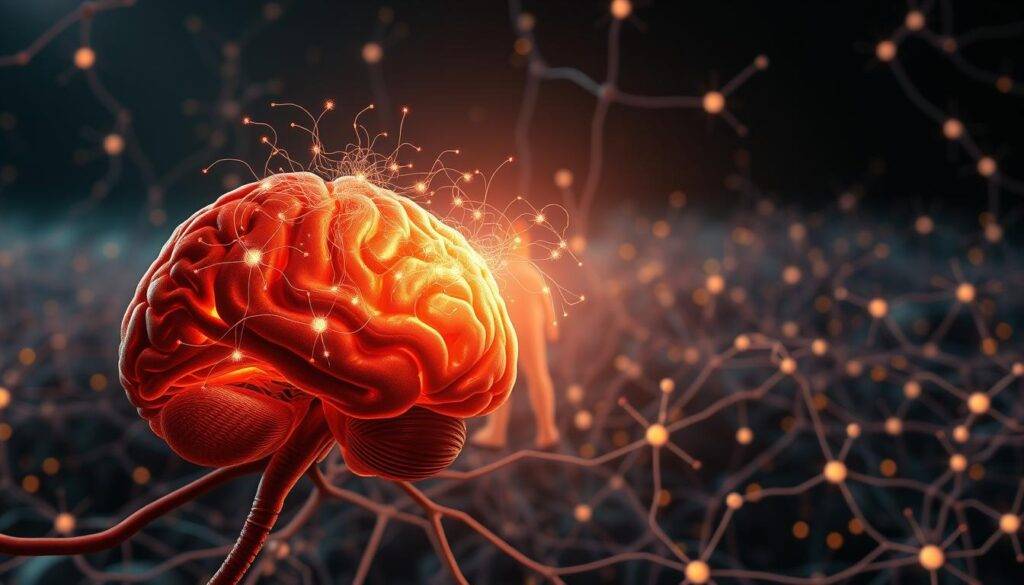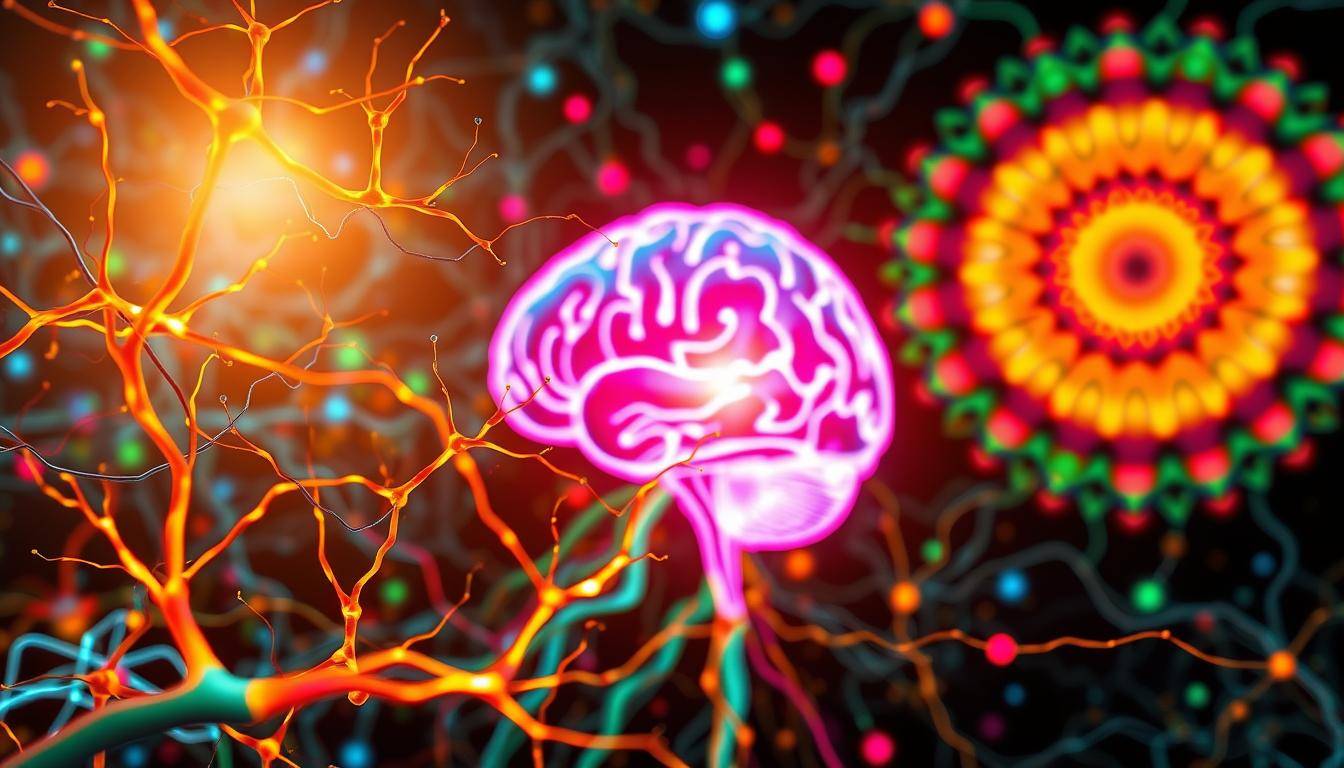Imagine Sarah, a marketing executive who spent years scrolling social media during her morning coffee. By 9 AM, her focus was shattered – until she discovered a brain-based strategy to reclaim her mornings. Within three months, she replaced her default routine with meditation and strategic planning. Her secret? Understanding how neural pathways adapt through deliberate practice.
This transformation isn’t magic – it’s neuroscience. Dr. Jeffrey Schwartz’s research on self-directed neuroplasticity reveals how focused attention can reshape the brain. Unlike passive learning (called experience-dependent neuroplasticity), intentional repetition creates lasting change. As Dr. Rick Hanson explains, “Neurons that fire together wire together” – but you control the spark.
January offers a unique advantage for change. The new year creates a psychological reset point, making it easier to get started. However, lasting shifts require more than motivation. This article explores practical systems to break autopilot behaviors and build routines aligned with your goals. You’ll learn how to leverage small daily actions, design supportive environments, and measure progress without burnout.
Key Takeaways
- Neuroplasticity allows the brain to change at any age through focused effort
- Self-directed practice outperforms passive habit formation
- Consistent daily repetition strengthens new neural pathways
- Strategic systems beat willpower for lasting transformation
- January’s fresh-start effect enhances commitment to change
Understanding Habit Formation and the Habit Loop
Forty-three percent of daily actions occur unconsciously – a testament to how deeply routines shape human behavior. These automated patterns free up mental bandwidth but can also lock people into cycles that no longer serve their goals. By decoding the science behind these processes, individuals gain power to redesign their daily lives intentionally.

What Are Habits and Why They Matter
The brain converts repeated actions into automatic routines through the basal ganglia – neural structures that handle pattern recognition. While the prefrontal cortex manages new decisions, this energy-intensive region hands off familiar tasks to more efficient systems. As Psychology Today notes, this biological system explains why established behaviors feel effortless compared to new practices.
The Cue-Routine-Reward Cycle Explained
MIT researchers identified a three-part neurological blueprint driving repetitive actions. A cue (like phone vibrations) triggers a routine (checking notifications), followed by a reward (dopamine release from social validation). Charles Duhigg, author of The Power of Habit, emphasizes:
“Once the brain connects specific triggers with anticipated rewards, the loop becomes self-perpetuating.”
This mechanism explains why 80% of New Year’s resolutions fail by February – old neural pathways override conscious intentions. Recognizing these cycles allows individuals to disrupt automatic responses. Start by identifying which ones occur every day without deliberate choice, then strategize replacements aligning with personal objectives.
How the Brain Rewires Habits: Neuroplasticity Explained
Neuroplasticity isn’t just a buzzword—it’s your brain’s secret weapon for change. This biological process allows neural networks to reorganize through experience, creating new pathways while weakening unused ones. Dr. Sanam Hafeez, a neuropsychologist, notes:
“Every repeated action—whether making coffee or checking your phone—leaves a trace in your neural architecture.”

Active vs. Passive Neural Remodeling
Your brain changes through two distinct processes. Self-directed neuroplasticity occurs when you consciously practice new behaviors—like choosing meditation over social media scrolling. This active approach triggers long-term potentiation, strengthening connections between neurons through deliberate repetition.
In contrast, experience-dependent neuroplasticity happens passively. Your brain automatically adapts to daily patterns without conscious effort. For example, reaching for snacks while watching TV becomes ingrained through repeated cue-reward cycles.
Research reveals why consistency matters. A University College London study found new routines take approximately 66 days to become automatic. Small daily actions—even five minutes of journaling—build stronger neural connections than occasional intense efforts.
Notice what triggers your automatic behaviors. Is it time of day? Location? Emotional state? By mapping these cues, you gain power to reshape responses. Your mind’s adaptability turns intentional actions into lasting change—one neural pathway at a time.
Creating Your Habit Rewiring Plan
What separates successful transformations from abandoned resolutions? A structured approach grounded in cognitive behavioral principles. Begin by mapping your current patterns – the invisible architecture shaping daily choices.

Setting Realistic Short-Term Goals
Break ambitions into 30-day sprints. Instead of “exercise daily,” aim for “10-minute walks after lunch.” Research shows bite-sized goals activate the brain’s reward system more effectively than vague targets. Use this framework:
| Goal Type | Example | Immediate Reward |
|---|---|---|
| Behavioral | Drink water before coffee | Checkmark on tracker |
| Environmental | Place journal on nightstand | Colorful sticker |
| Emotional | Pause before reacting | Deep breath + smile |
Using Reflection and Journaling for Lasting Change
Documenting actions creates accountability while strengthening neural pathways. Try this nightly exercise:
- Note one automatic behavior you want to change
- Describe the physical sensations accompanying it
- Write an alternative response for next time
This subconscious reprogramming technique helps disrupt existing habit loops. Pair entries with positive affirmations to rewire your brain’s default responses. Over time, these micro-shifts anchor new routines through consistent practice.
Habit Rewiring: Strategies to Break Old Patterns
Ever reach for your phone when stressed, only to feel more drained? This automatic response highlights how deeply ingrained patterns influence daily choices. Strategic replacements—backed by neuroscience—can transform these moments into opportunities for growth.
Replacing Negative Routines with Positive Ones
Dr. Tom Kannon suggests a swap-and-replace method. “Identify the emotional need behind a behavior,” he advises. “Instead of stress-eating, try four deep breaths. Both calm the brain, but one builds healthier pathways.”
Real-world examples prove this works. A financial analyst replaced afternoon candy breaks with 10-minute walks. Within weeks, her energy stabilized—and she naturally chose healthier snacks. The key? Matching the reward while upgrading the action.
Small Steps: The Power of Mini-Habits
James Clear’s research reveals why tiny actions succeed where grand plans fail. “Two minutes of stretching beats an hour at the gym when starting physical activity,” he notes. These micro-commitments bypass resistance in the mind.
Try this approach:
- Swap soda for flavored water (same thirst-quenching reward)
- Do five push-ups during TV ads (builds consistency)
- Write one gratitude sentence before bed (rewires focus)
Daily goals lasting under five minutes create compound benefits. Over time, they create new neural shortcuts that align with your deepest priorities—no willpower required.
Leveraging Science-Backed Techniques for Habit Change
Meet David, a high school teacher who transformed his afternoon slump into productive writing sessions. His breakthrough came not from willpower, but by applying brain-based strategies that align with how neural networks adapt. Science reveals specific methods to accelerate behavioral shifts—tools anyone can use to design their ideal routines.
Visualization and Positive Affirmations
Mental rehearsal activates the same neural circuits as physical action. A 2022 UCLA study found participants who visualized practicing piano for 10 minutes daily showed measurable growth in motor cortex connections. “Your brain doesn’t distinguish between vivid imagination and real experience,” notes neuroscientist Dr. Tara Swart.
Pair visualization with affirmations to amplify results. Repeating phrases like “I choose energizing activities” strengthens prefrontal cortex pathways linked to self-control. Research in Social Cognitive and Affective Neuroscience shows this combo reduces stress hormones by 23% during challenging transitions.
Habit Stacking and Environmental Cues
James Clear’s Atomic Habits method proves small changes create big shifts. Attach a new routine to an existing trigger:
“After brushing my teeth (current habit), I’ll do two minutes of deep breathing (new action).”
Redesign your space to support goals. Place workout clothes by the bed or keep a water bottle on your desk. These cues work because the brain responds to visual prompts faster than conscious decisions.
| Technique | Brain Impact | Time Required |
|---|---|---|
| Visualization | Strengthens motor cortex | 3-5 minutes |
| Habit Stacking | Links new/old neural pathways | 1 minute planning |
| Environmental Design | Triggers automatic responses | 10-minute setup |
Apps like HabitBull or Streaks provide tracking systems that reinforce the neuroscience of habit formation. Combine these tools with weekly reflection—what worked? What needs adjusting? Experimentation helps discover which strategies best support your mental health and long-term growth.
Overcoming Common Pitfalls in Habit Formation
A Harvard Business Review study reveals 81% of resolutions collapse by February—not from lack of effort, but flawed strategies. Changing too many routines at once overwhelms the brain’s capacity for new habits, while unrealistic goals trigger frustration. The solution lies in designing systems that work with your biology rather than against it.
Navigating the Consistency Challenge
Setbacks aren’t failures—they’re neurological feedback. When you skip a day of exercising regularly, the brain’s existing pathways temporarily regain dominance. CDC research shows those who restart after lapses have 73% higher long-term success rates than perfectionists.
Try these science-backed approaches:
- Pair new actions with existing triggers: Do 5-minute stretches after brushing teeth (linking to an established routine)
- Redesign your space: Keep resistance bands by the TV to encourage physical activity
- Use the “next time” method: After a missed session, write “Tomorrow I’ll…” to reactivate commitment
“Consistency beats intensity. Three 10-minute walks weekly create stronger neural patterns than one hour-long gym visit.”
Building positive routines at home starts with micro-commitments. Start with two push-ups daily rather than 50. These tiny wins strengthen the prefrontal cortex’s ability to maintain new habits through what psychologists call “success spirals.”
Track progress visually—a calendar with gold stars for completed practice sessions taps into the brain’s reward system. Over time, these small steps forge durable pathways that make desired behaviors feel automatic.
How to Incorporate Technology for Habit Trackers and Support
Your phone buzzes—not with a notification, but a reminder to hydrate. This simple alert demonstrates how technology can become an ally in reshaping daily patterns. Digital tools transform abstract goals into actionable steps, working with your brain’s natural wiring to reinforce new habits.
Using Apps, Calendars, and Online Tools
Apps like Streaks or Habitica turn behavior change into a game. These platforms use visual progress bars and achievement badges that trigger dopamine release—the same reward chemical that drives automatic routines. Studies show people who track exercise digitally are 33% more consistent than manual trackers.
Google Calendar’s color-coded blocks make routines tangible. Schedule a 15-minute “mindful breathing” slot each morning. The visual cue strengthens prefrontal cortex engagement, helping you act intentionally rather than reactively. As habit formation experts suggest, pairing digital reminders with existing triggers creates powerful neural associations.
Online communities add social accountability. Fitness groups on Reddit or LinkedIn challenge members to post daily workouts. This taps into the brain’s innate desire for social validation—redirecting it toward good habits. When others celebrate your progress, it reinforces the behavior loop.
Start small. Set a two-minute “tech check-in” each evening using Todoist. Review what worked and plan the next time you’ll practice your target action. These brief sessions may help build momentum right away, turning sporadic efforts into automatic responses.
Expert Insights and Success Stories in Habit Rewiring
Dr. Tom Kannon offers a game-changing perspective: “The brain doesn’t care if a behavior helps or harms you—it only recognizes repetition.” This neural truth explains why both positive and negative routines become automatic. Leading professionals reveal how to leverage this understanding for lasting improvements.
Wisdom from Behavior Science Pioneers
Neuroscientist Dr. Rick Hanson’s Hardwiring Happiness method shows how brief daily practices reshape thinking patterns. “Spending 30 seconds savoring positive experiences strengthens neural networks for resilience,” he explains. Fitness expert Catherine Roscoe Barr adds:
“Clients who track activity in 15-minute blocks triple their consistency compared to hour-long goals.”
Proof Through Personal Journeys
Software developer Mark T. replaced late-night scrolling with yoga stretches. Within eight weeks, his sleep quality improved by 40%—a change visible in his brain’s hippocampal growth via MRI scans. Social media manager Lena D. used app blockers to create “focus zones,” boosting her productivity while maintaining client engagement.
These successes highlight three key lessons:
- Small daily actions (as little as 5 minutes) compound into measurable mental health improvements
- Tracking tools transform abstract intentions into concrete brain changes
- Setbacks become stepping stones when viewed as neurological feedback
Dr. Kannon notes: “What we call failure is often the brain’s way of requesting clearer cues or more immediate rewards.” By combining expert strategies with personalized adjustments, sustainable transformation becomes not just possible—but probable.
Conclusion
Your brain thrives on repetition—a truth that holds both challenge and opportunity. Through deliberate practice, anyone can reshape automatic behaviors into intentional routines. Studies show people who pair visualization with habit stacking triple their success rates compared to willpower alone.
Start small. Replace social media scrolling with five minutes of stretching, or swap sugary snacks with flavored water. These micro-changes build neural pathways that make progress feel natural over time. Track wins using apps or journals—tools that help get you back on track after setbacks.
Remember: failure isn’t defeat. It’s neurological feedback guiding adjustments. Dedicate attention to your environment—place resistance bands by the TV or schedule walking meetings. At home, these tweaks could also spark lasting shifts.
Ready to exercise your brain’s adaptability? Begin today. Set one clear goal—like hydrating before coffee—and celebrate each success. With science-backed strategies and consistent effort, transformation becomes inevitable, not impossible.
FAQ
How long does it take to rewire daily routines effectively?
Research from institutions like University College London suggests it typically takes 2–8 months for new patterns to stick. Consistency matters more than speed—focus on repeating intentional actions until they feel automatic. Tracking progress with tools like HabitBull or Streaks can provide motivation during this process.
Can changing environments really influence behavior shifts?
Yes. Environmental cues—like keeping workout gear visible or disabling social media notifications—directly impact choices. Stanford researcher BJ Fogg emphasizes designing spaces that make desired actions easier. For example, placing a water bottle on your desk encourages hydration without conscious effort.
What’s the fastest way to stop unwanted behaviors?
Interrupt the cue-routine-reward cycle by identifying triggers. If stress leads to snacking, replace eating with a 5-minute walk or breathing exercise. Apps like I Am Sober help track replacement activities while building accountability through community support.
Do visualization techniques actually work for creating routines?
Studies by neuroscientist Dr. Tara Swart show mentally rehearsing actions—like picturing morning workouts—strengthens neural pathways similarly to physical practice. Pair visualization with habit stacking (adding new tasks to existing routines) for better results.
How do apps like Habitica make behavior changes easier?
Gamification taps into the brain’s reward system by turning progress into achievable milestones. Earning points for completing tasks or “leveling up” releases dopamine, reinforcing positive patterns. However, experts recommend combining tech tools with handwritten journaling for deeper reflection.
Why do people revert to old patterns during stress?
Under pressure, the brain prioritizes energy-efficient familiar pathways. Psychologist Dr. Judson Brewer notes that mindfulness practices—like noting cravings without acting—help build pause points. Tools like Headspace offer guided sessions to strengthen this skill over time.
Can small actions like 2-minute exercises create lasting results?
Absolutely. James Clear’s “atomic habits” concept shows micro-changes reduce resistance to starting. A 2-minute plank daily builds consistency, which often expands naturally. Celebrate these wins—they rewire the brain to associate effort with achievement.
What role does sleep play in forming new routines?
Sleep consolidates learning and strengthens neural connections made during practice. Neuroscientist Dr. Matthew Walker explains that 7–9 hours nightly enhances memory retention of new skills. Apps like Sleep Cycle optimize rest quality to support this process.
How do experts recommend handling missed days?
NYU researcher Dr. Gabriele Oettingen advises treating slip-ups as data, not failure. Analyze what disrupted the routine, adjust your plan, and restart immediately. Perfection isn’t required—research shows 80% consistency still drives meaningful change.
Are group programs more effective than solo efforts?
Data from platforms like Noom and Fitbit Communities show social accountability increases success rates by 65%. Shared goals and encouragement activate brain regions linked to motivation. However, introverts may prefer private tracking with apps like Daylio.




























































